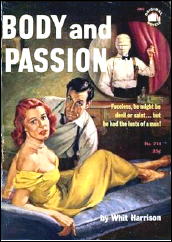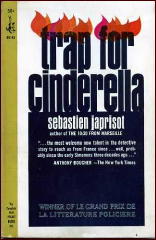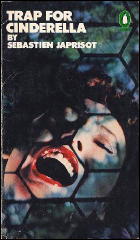Tue 4 Aug 2009
by Dan Stumpf:
Following my recent re-reading of Jack Kerouac’s On the Road and moving on to things more criminous, I found two books recently with the same cockamamie plot. (That’s funny: the spell check just now objected to “criminous” but let “cockamamie” slip by! Oh well.)

Start with the premise that two people who resemble each other are caught in a fire from which only one emerges, alive but scarred beyond recognition and also suffering from amnesia, so that no one, for purposes of the plot, knows which it is.
Then add that at least one of them was plotting to kill the other. Throw in a cast of venal supporting characters on each side who stand to profit, depending on who the survivor turns out to be, and you have the makings of an improbable but entertaining mystery.
Body and Passion (with one of my favorite paperback covers) by Whit Harrison — aka Harry Whittington — takes the tale along fairly conventional lines, with one character a notorious gangster and the other a crusading D.A., but he throws in some cute wrinkles as it turns out the crook may have been trying to quit the rackets and go straight, while the D.A. was possibly a crooked politician trying to frame him.
Both men were married to greedy wives who didn’t love them, and both were surrounded by dubious “friends” looking to jostle them out of the picture, by means unctuous and/or violent.

Whittington/Harrison deals this out with his usual serviceable prose, right up to a rather unsatisfying ending. Whittington was a competent and readable hack, but no more, and he delivers a competent and readable story — but no more.
In 1962, the astute French mystery writer Sebastien Japrisot re-did the premise with his own uniquely Gallic approach: instead of a Mystery, Trap for Cinderella becomes a study on the nature of love, guilt and existence.

The central character this time is a spoiled heiress, who supposedly survived a fire in which her paid companion, who may also have been her lover, was supposedly killed — both were burned beyond recognition, but the survivor was identified as the heiress by her long-time mentor, who may also have been her ex-lover.
Set in a milieu of the very very rich and the parasites who feed off them, Trap generates a sardonic paranoia as a face-less, past-less heroine keeps finding hints that whoever she is, she may have been a target of murder … or possibly plotting one of her own.
Japrisot tacks a richly ironic ending onto this. Not a surprising one, but a conclusion that seems to lift the story and its characters out of the pulp they inhabit for an instant and ask something about what they mean.
Bibliographic data:
WHIT HARRISON – Body and Passion. Original Novels #714; digest-sized paperback original; 1st printing, 1952. Reprinted as by Harry Whittington (Stark House Press, Spring 2009) as: To Find Cora / Like Mink Like Murder / Body & Passion.
SEBASTIEN JAPRISOT – Trap for Cinderella. Simon & Schuster, hardcover, 1964. Souvenir Press, UK, hc, 1965. US paperback reprints: Pocket, 1965; Penguin, 1979. Translation of Piege pour Cendrillon. Paris, 1962. Film: Gaumont, 1965, as Piege pour Cendrillon (Trap for Cinderella) (scw: Sebastien Japrisot, J. B. Rossi, Jean Anouilh, Andre Cayatte; dir: Cayatte).
August 13th, 2009 at 8:52 pm
[…] Speaking of Pulp, despite the title, Who Wants To Kill Jessie (1966) is not a murder mystery, but a Czechoslovakian pop-art sci-fi satire (you know the type) made the same year as Alphaville and sharing many of that film’s fetishes for pop culture and politics. […]